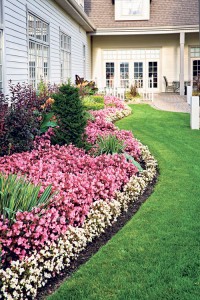A thriving landscape
This season, experts from Pennington Seed de-stress lawn and garden care with seven quick tips that will help reduce your outdoor water consumption, while keeping your landscapes lush, healthy and vibrant.
Don’t be overly reactive
Lawns tend to be overwatered, often with entire lawns being watered to avoid a few dry spots. Overwatering can cause numerous problems, including: shallow root systems; increased disease, weed or insect infestations; reduced drought tolerance; and increased thatch and excessive growth. A lawn does not need water until the color falls by 50 percent, at which time only one inch of water should be added.
Select water-efficient plants
By utilizing grass seed that requires less water, lawns are more resilient during periods of drought and easier to maintain (e.g. reduced time, energy and resources). Consider a pure-bred, drought-tolerant seed, like Pennington Smart Seed, which stays green for up to three weeks without water and requires 30 percent less water year after year versus ordinary seed.
Install water-saving systems
Install a drip irrigation system around trees and shrubs in your landscape to improve water efficiency. Drip irrigation applies water only when needed, minimizing water loss due to evaporation and preventing moisture from reaching spaces between plants — thus, limiting the chance of weed growth in those areas. Rain barrels also can be used to harvest rainwater for later use in landscapes as irrigation.
Water wisely
Water at night or in the morning to reduce the chance of water being lost to evaporation in the mid-day heat. This timing allows grass to retain moisture but dry in enough time to prevent diseases that are more likely to develop in a wet-lawn.
Retain moisture with mulch
Spread mulch when seeding new areas to add a protective layer over soil. The mulch allows soil to retain moisture during the critical seed germination and establishment stages. The clippings from mulching mowers also serve the same purpose — preserving soil moisture and nutrients.
Fertilize thoughtfully
Fertilization supplies plants with essential nutrients for strength, uniform growth and a healthy, fibrous root system. A vibrant and healthy plant makes the best use of available water, meaning less water is needed over time. There also is less chance of the plant being “burned” or dried out to a point beyond recovery. Fertilizers, however, should not be applied during periods of drought.
For more information and additional resources, visit www.penningtonseed.com.
This article is courtesy of Brandpoint.
